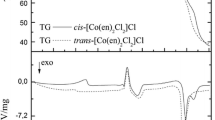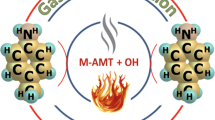Summary
-
1.
Capric acid undergoes oxidation with the elimination of CO2 in a medium of octadecane which is being oxidized. Oxidation of the acid proceeds to a definite limit, depending on the temperature. Semilogarithmic representations of the kinetic curves of acid oxidation, allowing for the limiting extent of oxidation, are straight lines whose slope is independent of temperature.
-
2.
The limited character of capric acid oxidation indicates the presence of a reaction-retarding process, which develops during the oxidation of octadecane. This retardation may be connected with shortening of the oxidation chains and a decrease in the rate of active center generation.
-
3.
The rate of esterification of capric acid during octadecane oxidation was studied. Analysis of the data obtained showed that the bulk of the esters was not formed as a result of esterification of acids by alcohols.
Similar content being viewed by others
Literature cited
M.B. Neiman, Zhur. Fiz. Khim. 28, 7, 1235 (1954).
A.F. Lukovnikov and M.B. Neiman, Doklady Akad. Nauk SSSR 91, 581 (1953).
A.F. Lukovnikov and M.B. Neiman, Zhur. Fiz. Khim. 29, 1410 (1955).
I.V. Berezin, L.S. Vartanyan, B.G. Dzantiev, N.F. Kazanskaya and N.M. Émanuél', Zhur. Fiz. Khim. 31, 2, 340 (1957).
I.V. Berezin, B.G. Dzantiev, N.F. Kazanskaya, L.N. Sinochluna and N.M. Émanuel', Zhur. Fiz. Khim. 31, 3, 554 (1957).
I.V. Berezin, L.G. Berezkina and T.N. Nosova, Coll.: Oxidation of Hydrocarbons in the Liquid Phase [in Russian] (Acad. Sci. USSR Press, Moscow, 1959).
A.A. Bag and N.V. Glikina, Author's Certificate No. 88626 from August 3, 1950.
G.D. Knoppe, Z.K. Maizus and N.M. Émanuél', Doklady Akad. Nauk SSSR 99, 3, 415 (1954).
I.V. Berezin and G.B. Meluzova, Zhur. Analit. Khim. 13, 4, 476 (1958).
V. Veksler, L. Groshev and B. Isaev, Ionization Methods of Investigating Radiation [in Russian] (State Tech.-Theoret. Press, Moscow-Leningrad, 1950).
M.O. Korshun and N.É. Gel'man, New Methods of Elementary Microanalysis [in Russian] (State Chem. Press, Moscow-Leningrad, 1949).
L.S. Vartanyan, Z.K. Maizus and N.M. Émanuél', Zhur. Fiz. Khim. 4, 856 (1956).
E.T. Denison, Zhur. Fiz. Khim. 31, 7, 1481 (1957).
A. Robertson and W. Waters, J. Chem. Soc. 1948, 1574.
W. Langenbeck and W. Pritzkow, Chem. Techn. 1952, 391.
F. Azinger, Chemie und technologie der Paraffin Konlenwasserstoffe Akademie-Verlag (Berlin, 1956).
Author information
Authors and Affiliations
Rights and permissions
About this article
Cite this article
Berezin, I.V., Ragimova, A.M. & Émanuél', N.M. The mechanism of ester formation and the reactions of acids in processes of liquid-phase oxidation of hydrocarbons. Russ Chem Bull 8, 1661–1666 (1959). https://doi.org/10.1007/BF00912100
Received:
Issue Date:
DOI: https://doi.org/10.1007/BF00912100




